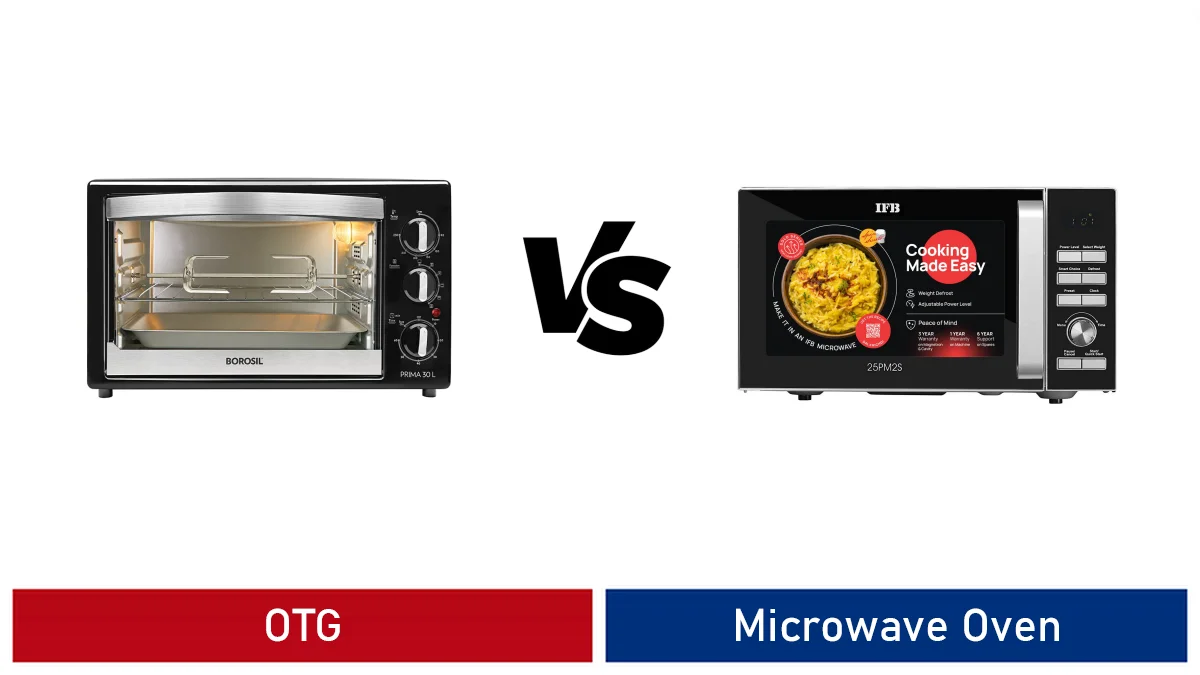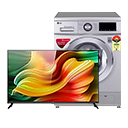
OTG vs Microwave Oven – In today’s fast-paced world, kitchen appliances play a vital role in simplifying meal preparation.
Two common kitchen appliances that often spark a debate are the OTG (Oven Toaster Griller) and the Microwave Oven.
In this comprehensive guide, we will compare these two appliances, exploring their features, benefits, and helping you decide which one is best suited for your cooking needs.
Contents
- 1. Understanding OTG (Oven Toaster Griller)
- 2. Understanding Microwave Ovens
- 3. Cooking Methods
- 4. Cooking Time and Efficiency
- 5. Versatility and Cooking Options
- 6. Health Considerations
- 7. Convenience and Ease of Use
- 8. Cost Comparison
- 9. Kitchen Space Considerations
- 10. User Preferences and Recipes
- Conclusion
- OTG vs Microwave Oven FAQs
1. Understanding OTG (Oven Toaster Griller)
- Brand: AGARO
- Colour: Black
- Control Type: Knob
- Door Style: Dropdown Door
1.1 How OTG Works
An OTG, or Oven Toaster Griller, is a compact oven designed for baking, toasting, and grilling.
It employs heating coils at the top and bottom to generate heat, which is controlled by the user. Here’s a closer look at OTGs:
1.2 Benefits of OTG
- Baking Precision: OTGs offer precise temperature control, making them ideal for baking cakes, cookies, and bread with precision.
- Grilling Perfection: They excel at grilling dishes like kebabs, sandwiches, and paneer tikka, providing the perfect char.
- Toasting Versatility: OTGs are exceptional for toasting bread, buns, and even pizzas to your desired level of crispiness.
- Roasting Excellence: They can roast vegetables and meats to perfection, creating savory dishes.
- Broiling Convenience: OTGs have a broil function for melting cheese and browning dishes.
1.3 Types and Sizes
OTGs come in various sizes, typically ranging from 10 to 60 liters.
Smaller OTGs are suitable for individuals and small families, while larger ones cater to more extensive cooking needs. Table 1 provides an overview of common OTG types and their ideal uses:
Table 1: Common OTG Types and Sizes
| Type | Capacity (Liters) | Ideal for |
|---|---|---|
| Mini OTG | 10-20 | Individuals and small kitchens |
| Standard OTG | 25-40 | Small to medium-sized families |
| Large OTG | 45-60 | Large families and advanced cooking |
2. Understanding Microwave Ovens
- Colour: Black
- Capacity: 30 litres
- Material: Metal
- Installation Type: Countertop
2.1 How Microwave Ovens Work
Microwave ovens, commonly known as microwaves, use electromagnetic waves to heat food.
They emit microwaves that excite water molecules in the food, generating heat throughout the item. Here’s a closer look at microwave ovens:
2.2 Benefits of Microwave Ovens
- Rapid Heating: Microwaves are incredibly efficient at quickly heating or reheating food, making them a time-saving option.
- Defrosting Convenience: They defrost frozen items swiftly and evenly, preserving the food’s quality.
- Even Heating: Microwaves ensure even heating without hotspots, eliminating the need for stirring.
- Versatile Cooking: Some microwave models offer additional cooking functions like grilling and convection baking.
- Compact Design: Microwaves are space-efficient, making them suitable for kitchens with limited space.
2.3 Types and Sizes
Microwave ovens come in various sizes, ranging from compact models to larger ones with advanced features.
Table 2 provides an overview of common microwave types and their ideal uses:
Table 2: Common Microwave Types and Sizes
| Type | Capacity (Liters) | Ideal for |
|---|---|---|
| Compact Microwave Oven | 15-20 | Individuals, small kitchens, and offices |
| Standard Microwave Oven | 21-30 | Small to medium-sized households |
| Convection Microwave Oven | 25-42 | Versatile cooking, baking, and roasting |
3. Cooking Methods
3.1 Cooking Methods in OTG
OTGs specialize in baking, toasting, grilling, and roasting. Here are the primary cooking methods associated with OTGs:
- Baking: OTGs provide precise temperature control, allowing you to bake cakes, cookies, and bread with perfection.
- Grilling: They are ideal for grilling dishes like kebabs, sandwiches, and vegetables, creating the perfect char.
- Toasting: OTGs excel at toasting bread, buns, and pizzas, offering customizable levels of crispiness.
- Roasting: You can roast vegetables, meats, and poultry to achieve savory and tender results.
- Broiling: OTGs come with a broil function for melting cheese and browning dishes.
3.2 Cooking Methods in Microwave Ovens
Microwave ovens focus on rapid heating, defrosting, and efficient cooking. Here are the primary cooking methods associated with microwave ovens:
- Heating and Reheating: Microwaves efficiently heat and reheat a wide range of dishes, from leftovers to beverages.
- Defrosting: They defrost frozen items swiftly and evenly, preserving the food’s quality.
- Convection Cooking: Some microwave models offer convection cooking, allowing you to bake, roast, and grill dishes.
While OTGs are versatile in baking and grilling, microwave ovens shine in quick heating and defrosting tasks.
4. Cooking Time and Efficiency
4.1 Cooking Time in OTG
OTGs are known for their precise temperature control, which is ideal for baking and roasting.
However, these processes often take longer in an OTG compared to a microwave. Baking a cake or roasting meat in an OTG can take more time but results in a crisp and evenly cooked dish.
4.2 Cooking Time in Microwave Ovens
Microwave ovens are renowned for their speed in heating and reheating dishes.
They significantly reduce cooking time, making them a convenient option for individuals with busy schedules.
While they may not achieve the same level of crispness as an OTG, they excel in rapid cooking.
In terms of energy efficiency, both OTGs and microwave ovens are relatively energy-efficient.
OTGs consume less power compared to conventional ovens, while microwave ovens are energy-efficient during short cooking tasks like reheating.
5. Versatility and Cooking Options
5.1 Versatility of OTG
OTGs are versatile for baking, grilling, toasting, and roasting.
They offer precise control over temperature and cooking time, making them ideal for a wide range of dishes. However, they lack the rapid heating capabilities of microwave ovens.
5.2 Cooking Options in Microwave Ovens
Microwave ovens offer a different kind of versatility. They specialize in quick heating and defrosting but can also include convection cooking functions.
Some microwave models can bake, roast, and grill with the added advantage of speed. However, they may not achieve the same level of crispness as an OTG.
6. Health Considerations
6.1 Health Benefits of OTG
Using an OTG can be healthier for certain cooking methods, as it allows you to control the amount of oil or butter used in baking and roasting.
This can result in dishes that are lower in fat and calories.
6.2 Health Considerations with Microwave Ovens
Microwave ovens are renowned for their efficiency in reheating and cooking, but health considerations depend on your cooking habits.
While they don’t inherently make food unhealthy, it’s essential to avoid using plastic containers that may release harmful chemicals when heated.
Use microwave-safe glass or ceramic containers for safe reheating.
7. Convenience and Ease of Use
7.1 Convenience of OTG
OTGs are known for their ease of use:
- Precise Controls: OTGs offer precise temperature and time controls, allowing you to tailor cooking to your needs.
- Visual Monitoring: You can visually monitor the cooking process through the oven’s transparent door.
- Maintenance: OTGs are easy to clean, with removable trays and grates for hassle-free maintenance.
7.2 Convenience of Microwave Ovens
Microwave ovens are celebrated for their convenience:
- Quick Cooking: They are ideal for individuals with busy schedules who need meals in a hurry.
- Effortless Cleaning: Microwaves have a simple interior design that is easy to clean.
- Automatic Functions: Many microwave models come with presets for common dishes, simplifying cooking.
While both appliances are user-friendly, OTGs provide more control, while microwave ovens offer unmatched speed.
8. Cost Comparison
8.1 Initial Cost of OTG
OTGs are available at various price points, with entry-level models starting at around $50 (around ₹4,000) and mid-range options ranging from $100 (around ₹8,000) to $300 (around ₹25,000) or more for advanced features.
8.2 Initial Cost of Microwave Ovens
Microwave ovens are cost-effective, with compact models starting at around $50 (around ₹4,000), standard models ranging from $100 (around ₹8,000) to $200 (around ₹15,000), and convection microwave ovens starting at $200 (around ₹15,000) and going up to $500 (around ₹40,000) for premium models.
8.3 Operating Costs of Both Types
Both OTGs and microwave ovens are energy-efficient.
However, OTGs may consume slightly more electricity during baking and roasting tasks. The difference in operating costs is generally minimal.
9. Kitchen Space Considerations
9.1 Space Considerations for OTG
OTGs come in various sizes, making it essential to choose one that fits your kitchen space.
Compact models are ideal for small kitchens, while larger ones may require dedicated countertop space.
9.2 Space Considerations for Microwave Ovens
Microwave ovens are designed to be space-efficient, making them suitable for kitchens with limited counter space.
They are also available in built-in models that seamlessly integrate into kitchen cabinetry.
10. User Preferences and Recipes
10.1 User Preferences
The choice between an OTG and a microwave oven ultimately depends on your cooking style, preferences, and the types of dishes you prepare most frequently.
Consider your needs and culinary goals when making a decision.
10.2 Recipes and Cooking Tips
Both appliances have their set of recipes and cooking tips. OTGs are ideal for baking, roasting, and grilling, while microwave ovens excel in quick heating and defrosting.
Explore recipes tailored to your chosen appliance and experiment with new dishes.
Conclusion
In the “OTG vs. Microwave Oven” debate, the choice hinges on your cooking style, preferences, and needs.
OTGs are perfect for those who enjoy baking, grilling, and roasting with precision. On the other hand, microwave ovens cater to individuals with busy schedules who value quick heating and defrosting.
Both appliances have their place in modern kitchens, simplifying meal preparation. Consider your culinary goals and available kitchen space when making your choice.
Whether you opt for an OTG or a microwave oven, both appliances enhance your cooking experience and make your kitchen a hub of culinary creativity.
OTG vs Microwave Oven FAQs
What is the main difference between an OTG (Oven Toaster Griller) and a microwave oven?
The main difference between an OTG (Oven Toaster Griller) and a microwave oven lies in their cooking methods and functionality.
An OTG primarily uses heating elements for baking, grilling, and toasting, providing even and direct heat.
In contrast, a microwave oven uses microwave radiation to cook or heat food quickly. Microwave ovens are versatile for reheating and cooking, while OTGs are better for baking and grilling.
Which appliance is better for baking, an OTG or a microwave oven?
An OTG is typically better for baking purposes. It provides even and direct heat, making it ideal for tasks like baking cakes, cookies, and bread.
Microwave ovens are not as suitable for baking due to their reliance on microwave radiation, which can result in uneven baking or cooking.
Can a microwave oven replace an OTG for cooking or baking?
While microwave ovens are versatile and can handle a variety of cooking tasks, they may not be a complete replacement for an OTG in terms of baking.
If you primarily bake, an OTG is the better choice. However, a microwave oven can be a convenient addition to your kitchen for reheating, cooking, and other tasks.
Are microwave ovens more energy-efficient than OTGs?
Microwave ovens are generally considered more energy-efficient than OTGs for tasks like reheating and cooking due to their quicker cooking times.
However, OTGs are efficient in their own right for baking and grilling. The energy efficiency of both appliances depends on how you use them.
Can I use both an OTG and a microwave oven in the same kitchen?
Yes, you can use both an OTG and a microwave oven in the same kitchen. They serve different purposes and can complement each other.
The OTG is best for baking, grilling, and toasting, while the microwave oven is excellent for reheating, cooking, defrosting, and various other tasks.
Having both appliances allows you to enjoy the benefits of both methods of cooking and food preparation.
|
Related Tags
Otg vs microwave oven which is better, otg vs microwave oven which is good for health, otg vs oven, otg microwave oven, advantages and disadvantages of otg oven, otg oven price, difference between otg and microwave oven in hindi, difference between otg and microwave convection oven
Last update on 2024-05-20 at 15:56 / Affiliate links / Images from Amazon Product Advertising API













